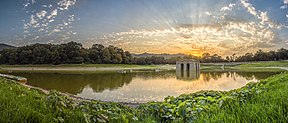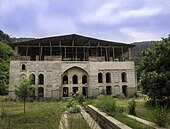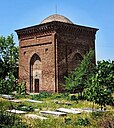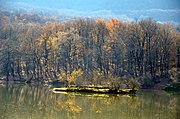City in Mazandaran, Iran
| Behshahr بهشهرAshraf or Ashraf-ol-Belād | |
|---|---|
| City | |
      | |
 | |
| Coordinates: 36°41′37″N 53°33′11″E / 36.69361°N 53.55306°E / 36.69361; 53.55306 | |
| Country | Iran |
| Province | Mazandaran |
| County | Behshahr |
| District | Central |
| Established | 1906 |
| Government | |
| • Mayor | Yaser Ahmadi |
| • City Council | Chairman: Abbas Asgaria |
| Population | |
| • Total | 94,702 |
| Time zone | UTC+3:30 (IRST) |
Behshahr (Persian: بِهْشَهْر) is a city in the Central District of Behshahr County, Mazandaran province, Iran, serving as capital of both the county and the district. It is located at the foot of the Alborz mountains, approximately 40 kilometres (25 mi) east of Sari and 80 kilometres (50 mi) west of Gorgan.
History
In 17th century AD, Ashraf became a site for the Safavid shah, Abbas the Great to build palaces and gardens, because of his devotion to his mother, who was born in Ashraf. The palace was named DiwanKhaneh mansion (fa:عمارت دیوانخانه) and was visited by Pietro Della Valle. In his travelogue he wrote:
" This garden, which is called Bagh-e Shah or Diwankhaneh, includes a square located at the end of the plain and at the foot of the hills full of trees and behind the palace. It is on the top of these hills that the king ordered to build many houses which are considered as garden mansions. Diwankhaneh is located in the middle of the garden and its length is three times its width. The front of this building is completely open, but at the back and on the sides has a wall covered with many windows. The floor of the building is two steps above the ground level, and the open part of the building faces north, that is, the back to the entrance door. There is a long paved street in front of the building, in the middle of which there is a stream, and water is constantly flowing towards this stream from the pond built in front of Diwankhanah."
Several other mansions and gardens were built on the outskirts of the Bagh-e Shah during the Safavid era such as Baghtappeh (tappeh garden), Cheshme Garden, Shamal Garden, Sahib Al-Zaman Garden, Haramsara Garden, and Khalut Garden, of which only Cheshme garden and parts of Baghtappeh have remained.
In 1832 David Brewster wrote in The Edinburgh Encyclopædia that "Ashraff is celebrated as the favourite residence of Shah Abbas, and enjoys the only good harbour on the southern side of the Caspian".
Prior to the arrival of Shah Abbas I Ashraf was a village of no distinction. The location took the fancy of Abbas I who made it an imperial residence in 1613 and he commissioned the construction of a palace and gardens. The heyday of the town was from that time until the middle of the 18th century. At the time that Sir Thomas Herbert visited the palace in 1628 there were about 2,000 families living in the town that at that time contained at least 300 public bath houses. However the town was the scene of both internal disorder and external threats (it was repeatedly sacked by Turkomans), so although it was still a significant town in 1727 when the peace of concluded the Ottoman–Persian War (1722–1727), the town was gradually abandoned. Jonas Hanway visited the town in 1744 when it was in a state of decay, and by 1812 when Sir William Ouseley visited there the palace was in ruins. By 1860 Ashraf was no more than a large village of 845 houses with between eight and ten thousand inhabitants.

20th and 21st centuries
Chit factory
In 1938, Behshahr's Chitsazi company was founded as a part of Mazandaran textile industry. After the Iranian Revolution, it was transferred to the national industries organization and in 1994 it was transferred to the Private sector.
According to Deputy minister of Labor during Mohammad Khatami's presidency, the factory had been in crisis since 1998 and from this year onwards, its workers' salaries were not paid for several months. Due to unhealthy management, the problems of this unit have not been solved in the years after being transferred to the private sector. Obsolescence and worn-out machinery was also a problem which caused a decrease in the quality of manufactured goods and a decrease in customers. The factory was closed in October 2000 and again on 24 October 2001 following workers' protests to receive arrears payment.
On 15 April 2006, one of the shareholders declared the bankruptcy of the factory, causing workers to protest. On 7 December of the same year, the head of Behshahr's Justice Department said that the court issued the preliminary verdict of bankruptcy.
A worker stated: "With its bankruptcy under the pretext of the debts of the public and private sectors and its wrong handing over to the private sector, more than two thousand households became unemployed." After the implementation of the failed privatization and transfer plan, the lands of Chitsazi factory went to auction, and the lands and properties and waste of the factory were divided between creditor workers, social security, taxes and other public and private creditors. The political and security deputy of Mazandaran governor at the time of the factory's bankruptcy said that the bankruptcy of the factory caused irreparable damage to the economy of the region and the province, which cannot be compensated soon.
Floods
In October 2012, heavy rain in Behshahr caused damaging floods in the city. 132 mm (5.2 in) of rain fell in one hour. Several houses and schools were damaged by the floods, leading to school closures. 6 people died in the food event. Crisis staff was formed right after the floods in the Rescue Organization of Red Crescent society.
Demographics
Population
At the time of the 2006 National Census, the city's population was 83,537 in 22,034 households. The following census in 2011 counted 89,251 people in 26,406 households. The 2016 census measured the population of the city as 94,702 people in 31,022 households.
Overview
The name Behshahr literally means "fine city". It includes many historical sites such as Behshahr the home of Abbas the Great, Cheshmeh Emarat Palace, Baghe Shah Gardens and the Chit Sazi weaving factor Abbas Abbad which is famous for its greenery and beauty and also its historic significance is a major tourism attraction. There is a road which leads up to a mountain through the jungle. In the touristic Abbas Abbad, the jungle surrounds a lake with a semi-destroyed castle in the middle. The castle once belonged to the Shah Abbas.
Behshahr is home to many famous Iranian figures ranging from actors to political figures. One of the more famous political figures from Behshahr is Ahmad Tavakkoli who once was a presidential candidate. Every year, famous members of the Iranian entertainment industry gather in Behshahr in a ceremony rewarding entertainers. More recently, such members included Parviz Parastui.
The city of Behshahr is an industrial city which produces Tokhme, vegetable oil, and a dish-soap known as Rika. Rika is the local term for son. Behshahr is home to Behshahr Industrial Company which is the biggest producer of vegetable oil in Iran since 1951. Recently, after scavenging near the suburbs of Behshahr, an ancient town was discovered which included nearly a thousand corpses of children to middle-aged men. The corpses had heights above the modern typical heights. In the area, gold and jars were found.
Climate
| Climate data for Behshahr | |||||||||||||
|---|---|---|---|---|---|---|---|---|---|---|---|---|---|
| Month | Jan | Feb | Mar | Apr | May | Jun | Jul | Aug | Sep | Oct | Nov | Dec | Year |
| Mean daily maximum °C (°F) | 12.1 (53.8) |
13.2 (55.8) |
16.4 (61.5) |
22.2 (72.0) |
27.4 (81.3) |
31.4 (88.5) |
33.4 (92.1) |
33.2 (91.8) |
30.7 (87.3) |
25.4 (77.7) |
19.8 (67.6) |
14.5 (58.1) |
23.3 (74.0) |
| Daily mean °C (°F) | 7.2 (45.0) |
8.2 (46.8) |
11.5 (52.7) |
17 (63) |
22.1 (71.8) |
26.3 (79.3) |
28.8 (83.8) |
28.4 (83.1) |
25.3 (77.5) |
19.5 (67.1) |
15.4 (59.7) |
9.4 (48.9) |
18.3 (64.9) |
| Mean daily minimum °C (°F) | 2.3 (36.1) |
3.3 (37.9) |
6.7 (44.1) |
11.8 (53.2) |
16.8 (62.2) |
21.3 (70.3) |
24.2 (75.6) |
23.7 (74.7) |
20 (68) |
13.7 (56.7) |
11.1 (52.0) |
4.4 (39.9) |
13.3 (55.9) |
| Average precipitation mm (inches) | 62 (2.4) |
37.6 (1.48) |
55.2 (2.17) |
24.3 (0.96) |
33.2 (1.31) |
36.9 (1.45) |
31.0 (1.22) |
35.5 (1.40) |
35.3 (1.39) |
77.0 (3.03) |
72.5 (2.85) |
56.6 (2.23) |
557.1 (21.89) |
| Average relative humidity (%) | 79.6 | 76 | 73.6 | 69.4 | 66.3 | 63.5 | 66.1 | 67.7 | 67.3 | 68.7 | 74.2 | 80.1 | 71.0 |
| Average dew point °C (°F) | 3.9 (39.0) |
4.2 (39.6) |
6.9 (44.4) |
11.4 (52.5) |
15.5 (59.9) |
18.8 (65.8) |
21.8 (71.2) |
21.9 (71.4) |
18.8 (65.8) |
13.6 (56.5) |
10.8 (51.4) |
6.1 (43.0) |
12.8 (55.0) |
| Mean daily daylight hours | 10.5 | 11.3 | 12.4 | 12.4 | 14.6 | 15.1 | 14.9 | 14 | 12.8 | 11.7 | 10.7 | 10.2 | 12.5 |
| Percent possible sunshine | 47.7 | 49 | 44.1 | 49.9 | 58.5 | 67.7 | 65.7 | 65.3 | 63.8 | 60.1 | 56.5 | 48.8 | 56.4 |
| Source 1: Weatherbase Weather2visit | |||||||||||||
| Source 2: IRIMO(Precipitation 1970-1978) | |||||||||||||
Tourism
- Abbas Abad Historical Complex
- Miankaleh peninsula
- International Miankaleh Lagoon
- Historical Sefidchah Cemetery
- Mellat Garden
- Ghohartape
- Museum of Behshahr Martyrs
- Palace Safiabad
- Palangan Castle
- Kusan Fireplace
- Asiab Sar Castle
- Sang No Waterfall
- Siami House
- Mellat Park (Chehel Sotoun Ashraf)
- Sikapol Bridge
- Tomb Amir Seyed Kamaluddin
Tourist attractions
Bagh-e Shah
Bagh-e Shah (باغ شاه), also known as Mellat Park, is a garden founded in 1021 AH (1612 AD) during the reign of Abbas the Great. It is located in downtown and is the seat of Behshahr city's municipality.
Huto and Kamarband Caves
Huto and Kamarband Caves, located west of the city and east of Shahidabad village, these caves were the habitats of Neanderthal humans. Excavations and explorations were made by Carleton S. Coon in 1951. The caves are notable for the human skeletons discovered there, dating to approximately 9000 years B.C. Other finds included flint blades, walrus and deer bones, giving valuable information about human development from the ice age in the Mazandaran area.
Cheshmeh Emarat
Cheshmeh Emarat (چشمه عمارت) meaning "Manor fountain". The reason for such naming is a spring that boils from the ground on the ground floor of the building. There are four ponds around the building, and the water flows from the central pond of the building to the four ponds by two streams from both sides. This structure was also built and started working in the Safavid period and was registered in the list of national monuments in 1973.
The building has a water supply system that brings water up from the spring without a pump and leaves the water in a river. The art and technique of the porcelain layer can be seen in this building as well as in other buildings of the Safavid period and can be found in abundance in Safavid mansions such as Chehel Sotoun or Ali Qapu. However, the climate of the region and the destruction and inattention over the years did not allow the art to be restored and displayed.
Abbas Abbad Garden

Located in the southeast of Behshahr in the midst of the Jungle and on the slopes of the Alborz mountain range, Abbasabad complex marks Iran's most prominent non-desert garden which comprises a lake, a palace, towers as well as bathhouse and a brick mansion in the middle of the lake. The complex was built by the order of Shah Abbas I with the use of a royal resort. With the passage of time and the fall of the Safavid dynasty, the garden was forgotten and buried in the heart of dense forests until, a part of the site and its artifacts were pulled out through continuous excavations by archaeologists over the years.
The dam lake covers an area of more than 10 hectares with brick mansion at the center which goes underwater when the dam is filled and only its upper surface is out of the water like an island. The lack of brick stairs in the building and around it has led to the assumption that the mentioned building was first built to strengthen the dam, and then it was given recreational use due to the dam's drainage.
The unique natural and architectural features of the garden and the location of a significant number of infrastructures in one complex placed this garden along with eight other Iranian gardens as a collection of Iranian gardens in the UNESCO World Heritage List in 2011 and Abbas Abad became the first globally registered site of Mazandaran.
Notable people
- Mulla Muhammad Ashrafi - Marja and Cleric Scholar
- Khayr al-Nisa Begum - Mother of Shah Abbas I, Wife of Mohammad Khodabanda
- Sardar Rafie Yanehsari - Military
- Ali Yachkaschi - Scholar in environmental science
- Ahmad Tavakkoli - Politician
- Ali Asghar Bazri - Wrestler
- Mousa Nabipour - Basketball player
- Ali Rahnama - Futsal player
- Behnam Ehsanpour - Wrestler
- Mehrdad Tahmasbi - Football player
- Mohammad Ami-Tehrani - Olympic weightlifting
- Anahita Hemmati - Actress
- Syyed Abdul Karim Hashemi Nejad - Dissident cleric
- Naser Kalantari - professional mixed martial artist
Gallery
-
 Sange No Waterfall
Sange No Waterfall
-
Shariat Shopping Mall
-
 Sinai Mansion
Sinai Mansion
-
 Abbas Abad Historical Complex
Abbas Abad Historical Complex
-
 Historic Cemetery of Ispechal
Historic Cemetery of Ispechal
-
 Cheshmeh Emarat
Cheshmeh Emarat
-
 Abbas Abad Garden
Abbas Abad Garden
-
 Abbas Abad Garden
Abbas Abad Garden
-
 Abbas Abad Garden
Abbas Abad Garden
See also
![]() Media related to Behshahr at Wikimedia Commons
Media related to Behshahr at Wikimedia Commons
Notes
- Also romanized as Behšahr; Mazanderani: بِهْشَهْر, romanized as Behšahr
References
- Also spelt Ashraff in some sources
- OpenStreetMap contributors (20 October 2024). "Behshahr, Behshahr County" (Map). OpenStreetMap (in Persian). Retrieved 20 October 2024.
- "شهردار بهشهر منصوب شد". ایمنا. 5 October 2021.
- ^ Census of the Islamic Republic of Iran, 1395 (2016): Mazandaran Province. amar.org.ir (Report) (in Persian). The Statistical Center of Iran. Archived from the original (Excel) on 7 October 2021. Retrieved 19 December 2022.
- Behshahr can be found at GEOnet Names Server, at this link, by opening the Advanced Search box, entering "-3055953" in the "Unique Feature Id" form, and clicking on "Search Database".
- Habibi, Hassan (c. 2024) . Approval of the organization and chain of citizenship of the elements and units of the divisions of Mazandaran province, centered in Sari city. lamtakam.com (Report) (in Persian). Ministry of the Interior, Defense Political Commission of the Government Council. Subject Letter 3233.1.5.53; Notification 83346/T144K. Archived from the original on 14 January 2024. Retrieved 14 January 2024 – via Lam ta Kam.
- M, Askari (19 December 2007). "Behshahr at a glance". behshahr86.blogfa (in Persian). Retrieved 23 March 2024.
- ^ "Behshahr's Bagh-e Shah". tripyar.com (in Persian). Retrieved 23 March 2024.
- "آشنایی با تاریخچه عمارت باغشاه بهشهر". anyja (in Persian). Retrieved 23 March 2024.
- ^ Brewster 1832, p. 461.
- Fisher, Jackson & Lockhart 1986, p. 396.
- Arnold 2004, p. 87.
- Houtsma 1987, pp. 484–485.
- "Deputy minister of Labor: To solve the Behshahr's chitsazi workers there is no solution but to sell the company's properties" (in Persian). The Islamic republic news agency. IRNA. 19 April 2003. 6765589. Retrieved 3 April 2024.
- "A look at the state of textile industries in Mazandaran" (in Persian). The Islamic republic news agency. IRNA. 30 October 1995. Retrieved 3 April 2024.
- "Representative of Behshahr: The government appoints a new director of the chit factory". Irna (in Persian). The Islamic republic news agency. 26 October 2000. Retrieved 3 April 2024.
- "Behshahr chit factory was reopened". Irna (in Persian). The Islamic republic news agency. 20 November 2001. Retrieved 3 April 2024.
- "A number of "Chitsazi" factory workers gathered in Behshahr". Irna (in Persian). The Islamic republic news agency. 15 April 2006. Retrieved 3 April 2024.
- "Chief Justice: Behshahr Chit Factory's bankruptcy order was issued". Irna (in Persian). The Islamic republic news agency. 7 December 2006. Retrieved 3 April 2024.
- "Final shot on the body of "Chit sazi"/ The aftershocks of false privatization in the economy of Mazandaran" تیرخلاص برپیکره «چیت سازی»/ پس لرزه های خصوصی سازی غلط در اقتصاد مازندران. tahlilbazaar (in Persian). Bazaar. 22 December 2019. Retrieved 3 April 2024.
- "6 people died in Behshahr floods. Schools are closed until further notice". Aftab news. Aftab news. 14 October 2012. Retrieved 16 February 2024.
- "Over 200 houses destroyed in Behshahr floods". khabareonline. khabaronline News Agancy. 13 October 2012. Retrieved 16 February 2024.
- Census of the Islamic Republic of Iran, 1385 (2006): Mazandaran Province. amar.org.ir (Report) (in Persian). The Statistical Center of Iran. Archived from the original (Excel) on 20 September 2011. Retrieved 25 September 2022.
- Census of the Islamic Republic of Iran, 1390 (2011): Mazandaran Province. irandataportal.syr.edu (Report) (in Persian). The Statistical Center of Iran. Archived from the original (Excel) on 19 January 2023. Retrieved 19 December 2022 – via Iran Data Portal, Syracuse University.
- Web search Archived September 3, 2005, at the Wayback Machine
- "Behshahr: MONTHLY - ALL WEATHER AVERAGES". Weatherbase. CantyMedia. Retrieved 16 February 2024.
- "Behshahr monthly weather averages". weather 2 visit. Retrieved 16 February 2024.
- "Monthly Total of precipitation in Behshahr (18350)". data.irimo.ir. Iran Meteorological Organization. Retrieved 24 May 2024.
Lat: 36.7167 Lon:53.55
- "Bagh-e Shah: Pleasant, Beautiful Garden in Behshahr". tasnimnews. Tasnim News Agency. 27 February 2019. Retrieved 23 March 2024.
- "Ancient caves of Huto and Kamarband". behshahr86.bogfa (in Persian). 22 December 2007. Retrieved 23 March 2024.
- ""Cheshmeh Emarat", Iranian garden in Mazandaran". tahlilbazaar. Bazaaar. 6 September 2022. Retrieved 24 March 2024.
- ^ Karimi, Fatemeh (9 November 2020). "Restoration of Behshahr's Manor fountain became historical!" مرمت چشمه عمارت بهشهر تاریخی شد (in Persian). Mehr News Agency. Mehr. 5066813. Retrieved 24 March 2024.
- ^ Qanbari, Fatemeh (4 March 2023). "Abbas abad, the historical complex in the heart of Mazandaran's nature". irna. The Islamic Republic News Agency. 85041792. Retrieved 24 March 2024.
- Arnold, Thomas W. (2004) , Painting in Islam: A Study of the Place of Pictorial Art in Muslim Culture, Gorgias Press LLC, p. 87
- Brewster, David, ed. (1832), "Persia: Mazenderan", The Edinburgh Encyclopædia, vol. 15, J. and E. Parker, p. 461
- Fisher, William Bayne; Jackson, Peter; Lockhart, Lawrence, eds. (1986), The Cambridge History of Iran, vol. 6 (illustrated, reprint, reissue, 7 Volume Set in 8 Pieces ed.), The Cambridge History of Iran, p. 396, ISBN 9780521246996
- Houtsma, M. Th, ed. (1987), "Ashraf", E.J. Brill's First Encyclopaedia of Islam 1913-1936, vol. 9, Brill, pp. 484–485, ISBN 9789004082656
External links
behcity, news and photos from behshahr city and county
| Mazandaran province, Iran | |
|---|---|
| Capital | |
| Counties and cities | |
| Sights |
|
| populated places | |